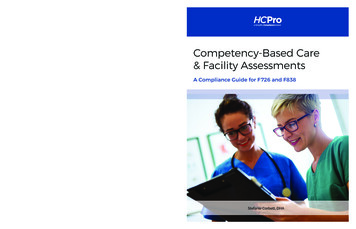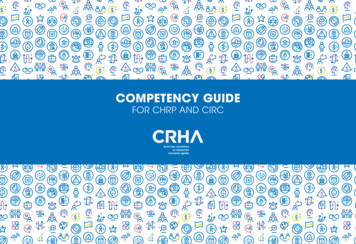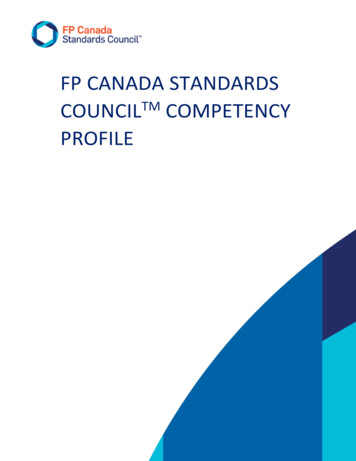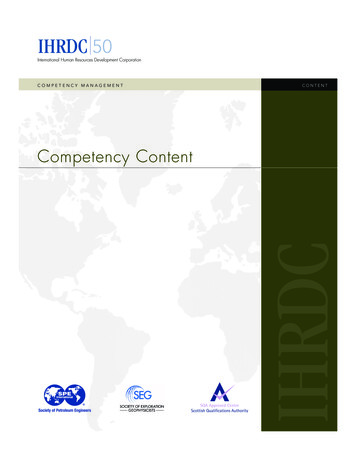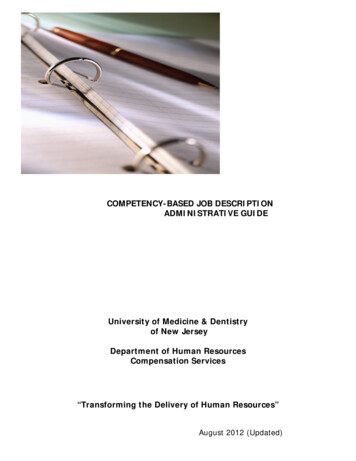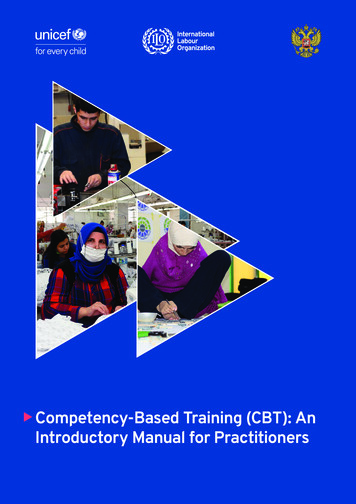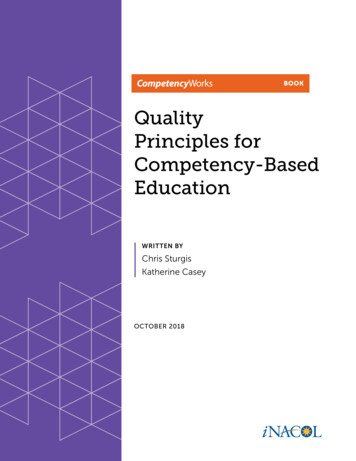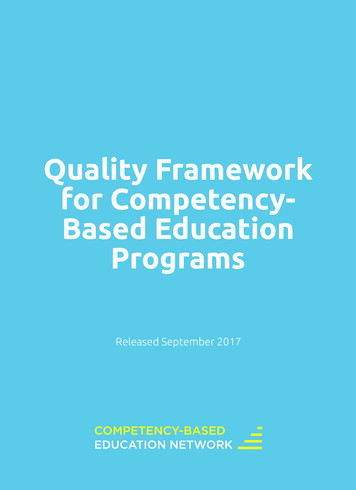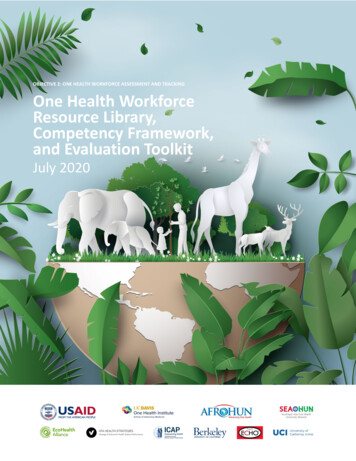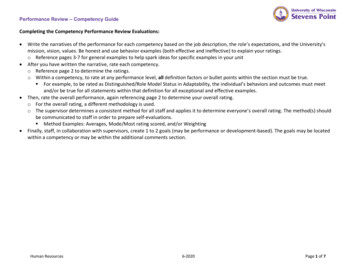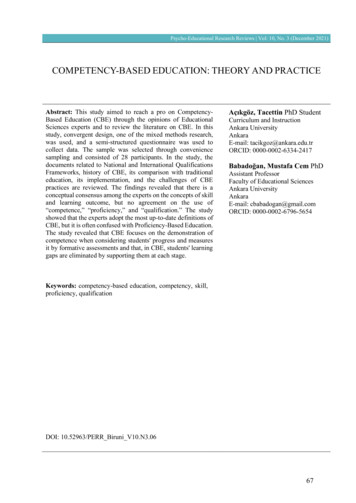
Transcription
Psycho-Educational Research Reviews Vol: 10, No. 3 (December 2021)COMPETENCY-BASED EDUCATION: THEORY AND PRACTICEAbstract: This study aimed to reach a pro on CompetencyBased Education (CBE) through the opinions of EducationalSciences experts and to review the literature on CBE. In thisstudy, convergent design, one of the mixed methods research,was used, and a semi-structured questionnaire was used tocollect data. The sample was selected through conveniencesampling and consisted of 28 participants. In the study, thedocuments related to National and International QualificationsFrameworks, history of CBE, its comparison with traditionaleducation, its implementation, and the challenges of CBEpractices are reviewed. The findings revealed that there is aconceptual consensus among the experts on the concepts of skilland learning outcome, but no agreement on the use of“competence,” “proficiency,” and “qualification.” The studyshowed that the experts adopt the most up-to-date definitions ofCBE, but it is often confused with Proficiency-Based Education.The study revealed that CBE focuses on the demonstration ofcompetence when considering students' progress and measuresit by formative assessments and that, in CBE, students' learninggaps are eliminated by supporting them at each stage.Açıkgöz, Tacettin PhD StudentCurriculum and InstructionAnkara UniversityAnkaraE-mail: tacikgoz@ankara.edu.trORCID: 0000-0002-6334-2417Babadoğan, Mustafa Cem PhDAssistant ProfessorFaculty of Educational SciencesAnkara UniversityAnkaraE-mail: cbabadogan@gmail.comORCID: 0000-0002-6796-5654Keywords: competency-based education, competency, skill,proficiency, qualificationDOI: 10.52963/PERR Biruni V10.N3.0667
Psycho-Educational Research Reviews Vol: 10, No. 3 (December 2021)INTRODUCTIONRegarding the role and function of knowledge, the goal which Ataturk set in 1926 for teachingand learning is a goal that every educator should pursue. It is true that sometimes we as thecountry drift away or deviate from the goals Ataturk pointed to in the opening ceremony of the4th legislative year of the 2nd Term of the Turkish Grand National Assembly. However, theaim of education in Turkey has been not only to turn knowledge into a tool, but also to enablestudents to develop certain skills. For example, as Bıkmaz (2013) stated, some of the aims of1924 Elementary Schools Curriculum were to enable students develop inquiry skills throughAgriculture and Health courses, observation skills through Geography, and communicationskills through Musahabat-ı Ahlâkiye, a course on moral values, and it can be said that theintegration of knowledge and skills was promoted through education. Apart from these,education has other functions. According to Moon (2007), education, by its nature, has twofunctions: it identifies and cultivates the potential abilities of each student, and it produces themanpower which is needed to carry out the maintenance of society and to support itsdevelopment. While the former is the self-actualization function of education, the latter is themanpower production function. Keeping the balance between these two has been one of themajor problems of nations. The amount of manpower lost its importance in the 21 st century:improving the abilities and competencies of all individuals and developing further theirpotential have assumed importance. In other words, two functions of education conjoined bycentering around the individual. Developing an individual's abilities and competencies isregarded as the only goal both for the business world and for the individual's self-realization.Unfortunately, nations are still in quest of providing an education pursuing this goal. One ofthese quests is Competency-based education.As Gervais (2016) stated, Competency-based education (CBE) is “a synthesis between a liberalarts education and the professional education movement.” Briefly, it is the redesign of thesystem that has developed over the last two centuries (Everett 2019). Also, this reform has beenconsidered among "innovative approaches and best practices" by the US Department ofEducation (ED 2011). In addition, increasingly, organizations such as the Carnegie Instituteand the United Nations focus primarily on “competency-based learning” in education reformefforts (Sullivan and Downey 2015).CBE puts forth the theory that the majority of students will achieve competence in the specifiedcontent area as long as they are given the opportunity and freedom to progress at their own paceand their learning experiences are structured according to their interests and needs (Priest,Rudenstine and Weisstein 2012; Steele, Lewis, Santibanez, Faxon-Mills, Rudnick, Stecher andHamilton 2014; Sturgis and Casey 2018). With this theory, CBE challenges the notion thatlearning takes place at a certain speed and place (Le, Wolfe and Steinberg 2014; Ryan and Cox2017; Spady 1977). In CBE, all students try to gain the desired level of mastery. For some, thiswill take a short time, while others will need more time to do so. In addition, some studentsmay have already acquired the knowledge and skills before starting their current educationlevel. They may have achieved these competencies through their previous experiences.However, showing their mastery of these competencies will be sufficient for them to progressin their learning. As can be understood, according to CBE, which is an outcomes-focusedapproach, time is seen as the variable, while performance as the constant (Stafford 2019).In the literature, the term competency can be used with standards and learning outcomes, orthey can be used interchangeably. Then, what is the difference between standards andcompetencies? Put simply, the standards are what students learn, while competencies are whythey learn (Bramante and Colby 2012). Stating that competencies are widely applicable skillsof which students need to achieve mastery in high school and beyond, and that they are morecomprehensive than content standards, Sturgis and Casey (2018) distinguished competenciesfrom content-specific standards. CBE is sometimes referred to as skill-based education.68
Psycho-Educational Research Reviews Vol: 10, No. 3 (December 2021)Competencies, however, often represent more than knowledge and skill levels: they require theeffective applications of existing knowledge and skills in certain context (Egodawatte 2014).Another example of "substitution" can be seen between learning outcomes and competencies.According to Klein-Collins (2013), competencies mean more than learning outcomes: they canbe measured, verified by evidence of student achievement, and applied in different situations.CBE is used in conjunction with such approaches as student-centered learning and personalizedlearning, is also used interchangeably with the terms of mastery-based education, proficiencybased education, and performance-based education (Le, Wolf and Steinberg 2014; Patrick,Kennedy and Powell 2013). At this point, it is necessary to state that there is no single definitionof CBE that scholars have agreed on even though various definitions of CBE have much incommon (Kelchen 2015; Gervais 2016; Evans, Landl and Thompson 2021). The absence ofagreement on the definition of CBE forms the basis of this study and emphasizes the importanceof the study.PURPOSE AND SIGNIFICANCE OF THE STUDYWith the advances in learning technologies, interest in CBE continues to grow in both K-12 andpost-secondary education, but research on CBE lags behind practice (Ryan and Cox 2017).Previous studies have focused on the implementation of CBE and examined the effects ofdifferent CBE approaches on student achievement. In addition, factors that hinder andcontribute to the implementation of CBE have frequently been examined. However, thesestudies have failed to accumulate scientific knowledge on CBE and to integrate the relevantliterature. Studies carried out also do not provide information about what is known about CBEand how the research on the factors affecting implementation should progress. Morrison (2018,25) states that CBE and Competency-Based Learning are used interchangeably and this resultsfrom "the lack of a common framework and vernacular". Levine and Patrick (2019) think thatthere is a problem of sameness between the concept and definition of CBE. Evans, Landl andThompson (2021) thoroughly examine the research on CBE between 2000 and 2019 to integratethe literature. They draw attention to the absence of a common definition and language in thestudies examined and state that this causes CBE to be interwoven with concepts such aspersonalized learning, student-centered learning, proficiency-based education. They mentionthe difficulties policymakers, researchers, and practitioners experience in identifying researchtopics and filling knowledge gaps without integrity. They suggest that research should becarried out to thoroughly examine the literature and to reach a conceptual consensus.The CBE's aim from past to present is to improve the overall quality of education and toeliminate or reduce the learning gaps that have accumulated over the years (Lewis, Steele,Santibañez, Stecher, Hamilton, Faxon-Mills, and Rudnick 2013). Like many educational reforminitiatives, CBE aims to reduce inequalities in education systems and achievement gaps amongstudents (Evans, Graham, and Lefebvre 2019), to identify and cultivate the unique intellectual,emotional and physical abilities of all individuals to lead successful lives (Moon 2007). Thisset of aims is also shared by researchers who are education specialists. However, in order toachieve these goals, it has been seen that it is necessary to understand CBE with a qualitativeparadigm, to ensure that it is understood and to provide a conceptual consensus. It is thoughtthat the policies implemented without understanding do not reach the aim.On the other hand, it is thought that, in Turkey, the elements of CBE are intertwined in conceptssuch as "skill-based education", "skill-based questions" and "qualifications-based education",there is no common language and there is not enough discussion on it. Considering these, thereare two primary aims of this study: to reach a conceptual consensus on Competency-BasedEducation in the light of the opinions of the experts in Educational Sciences and to compileexisting literature on Competency-Based Education by reviewing international literature. Toachieve this aim, this study seeks to investigate the following questions:69
Psycho-Educational Research Reviews Vol: 10, No. 3 (December 2021)1) How do experts in Educational Sciences perceive and these concepts of skill, ability,competence, proficiency, qualification, learning outcome, and competency-based education?2) How do qualifications frameworks and competency-based education relate?3) How is competency-based education seen in theory and practice?METHODIn this study, convergent design, one of the mixed methods research, was used. Convergentdesign is a mixed methods design in which the researcher collects and analyses qualitative andquantitative data at the same stage of the research process, and then combines these data andmakes a single interpretation. There are four major steps in the convergent design. First,qualitative and quantitative data are collected. This data collection is simultaneous and separate.Secondly, the collected data is analyzed separately. In the third step, the results obtained fromthese analyzes are tried to be combined. In the final step, the two result sets are compared andan overall understanding is sought (Creswell and Plano-Clark 2017). The research wasconducted simultaneously and separately as qualitative and quantitative processes in order toreach conceptual consensus on CBE and to examine and compile CBE in line with internationalliterature. The separate results illuminated the different problems of the research, and finally asingle goal was achieved.Convergent design variants may differ from the main design. There are three main variants ofconvergent design in the literature. These are the parallel-database variant, the datatransformation variant, and the data validation variant. In the questionnaire prepared by theresearchers in the data validation variant, both open-ended and closed-ended questions are usedand it is aimed to verify the results of the open-ended questions and the results of the closedended questions. Qualitative items provide the researcher with new themes and interestingquotes to validate quantitative research findings (Creswell and Plano-Clark 2017). Datavalidation variant was used in the quantitative part of the study. When it comes to CBE, theconcepts of competence, qualification, proficiency, ability, skill, and learning outcome arefrequently used in the literature. It is seen that concepts such as competence-based education,skill-based education, and proficiency-based education are used in similar meanings in relationto these concepts. In the questionnaire created to provide consensus in these concepts, multiplechoice items and Likert scale items aiming to reach quantitative data and open-ended qualitativequestions were used to confirm and support these items.The scope of this study consists of the opinions of the experts in Educational Science aboutCompetency-Based Education and the curriculum and instruction field in the literature. Theimplementation of CBE in the fields of medicine and human resources is excluded from thescope of the research.STUDY GROUPConvenience sampling, one of the non-random sampling methods, was used to recruit theparticipants of the study. Yıldırım and Şimşek (2013) state that this sampling method increasesthe speed and practicality of research is often preferred in cases where researchers are not ableto use other sampling methods. The current Covid-19 pandemic has made it difficult to reachparticipants and to have face-to-face interviews. Convenience sampling method, therefore, wasemployed in this research. The experts who were expected to participate in the study wereselected according to their expertise in the academic database of the Council of HigherEducation in Turkey (i.e., YÖK Academic). In total, 120 faculty members from Curriculum andInstruction (CI) and 30 faculty members from Measurement and Evaluation in Education(MEE) were contacted via e-mail and 28 of these faculty members agreed to participate in thestudy. As a result, the sample consisted of 28 experts, 25 of whom were working in CI and 5 ofwhom were in MEE. In the study, experts from CI were coded from Pc1 to Pc23, and MEE70
Psycho-Educational Research Reviews Vol: 10, No. 3 (December 2021)experts from Pm1 to Pm5. Demographics of the participants other than their area of expertisewere not asked in the questionnaire.DATA COLLECTION TOOLThe questionnaire used in the study was constructed by the researchers by reviewing therelevant literature. The questionnaire consisted of two sections. In the first section, there were15 items related to the definitions of ability, qualification, competence, proficiency, skill, andlearning outcome found in the literature and used in various studies. Participants were asked tochoose one or more of the options available and to decide which of the given definitions wouldbe appropriate to use with which concept. Participants were able to write their own conceptsuggestions in the open-ended questionnaire item when they believed that the concepts givenin the options were not related to the definitions. In the second section of the questionnaire, 10definitions of CBE found in the literature were presented as an option, and participants wereasked to indicate their level of agreement on these definitions. In addition to this, their opinionsabout CBE were asked through an open-ended question. After this data collection tool wasconstructed, expert opinion on it was sought, and then, the questionnaire was edited andfinalized accordingly.DATA COLLECTION AND ANALYSIS"Informed Consent Form", "Ethics Committee Report" and "Online Form of Data CollectionTool" were sent to the official e-mail addresses of 28 experts who accepted to participate in thestudy. Participants' responses to the questionnaire were accepted through the e-mail addressesof the researchers in the following fifteen days.Descriptive statistics such as frequencies and percentages, content analysis, and descriptiveanalysis methods were used in the analysis of the data collection tool, which consisted of twosections. In the first section, the participants marked with which concept the definitions givenshould be used. In addition to this, they expressed their concept suggestions in the open-endedquestion through the "other" option. The data obtained from 15 items in this section wereanalyzed by using descriptive statistics including frequencies and percentages. The answers thatthe participants wrote in the "other" option were analyzed by using descriptive analysis andverbatim quotations from the participants were reported. In the second section, the participants'level of agreement on the definitions of CBE was described by using percentages andfrequencies whereas content analysis and descriptive analysis were used to analyze their viewson CBE. However, instead of an inductive approach, a deductive approach to content analysiswas implemented in this process since it enables the examination of the concepts that aredescribed clearly and theoretically. According to Yıldırım and Şimşek (2013), descriptiveanalysis consists of (1) creating a framework for descriptive analysis, (2) processing the dataaccording to the thematic framework, (3) describing the findings, and (4) interpreting thefindings. The stages of content analysis are described as (1) coding data, (2) finding themes, (3)organizing codes and themes, and (4) describing and interpreting findings. However, deductivecontent analysis was carried out in this study through the following stages: (1) identifyingthemes, (2) organizing codes and themes, (3) coding data, (4) describing and interpreting thefindings. Identifying themes also functioned as the necessary framework to begin descriptiveanalysis.The question in the section where participants' opinions on CBE were asked included twothemes. First, it was about participants' opinions on the definition of CBE, and second, abouttheir use of alternative concepts. The data related to this section were coded and analyzed inline with the themes in the question. Thirteen participants, all of whom were experts in CI,responded to this question. In the scope of the framework developed by content analysis, theopinions of the participants were analyzed through descriptive analysis and presented withverbatim quotations.71
Psycho-Educational Research Reviews Vol: 10, No. 3 (December 2021)A systematic literature review was conducted in order to examine and compile the internationalliterature. Key concepts such as "competence," “qualification,” “competency-based education,""proficiency-based education", "qualifications frameworks" were investigated in manydatabases and the data obtained were analyzed descriptively and compiled. As a result of theliterature review, studies carried out in the fields other than educational sciences were notincluded in the scope of the research.In order to ensure the reliability of the data, an in-depth literature review was conducted todetermine the concepts to be included in the questionnaire. Studies related to CBE were scannedand concepts closely related to this concept were included in the research. The opportunity toadd to these concepts was provided to the participants with “other” options. For the surveyitems, an item pool was created as a result of the literature review and document review of therelevant documents, and the most understandable and most accepted items were selected fromthis pool. In the data collection tool, in accordance with the research method, quantitative itemssuch as multiple choice items and Likert scale items and open-ended qualitative items wereincluded to confirm and support them. Variation of data sources is one of the measures takenfor reliability. Expert opinion was sought in order to ensure the content validity of thequestionnaire draft form prepared by the researchers. Opinions of a faculty member who areexperts in the field of CBE, Curriculum and Instruction, and Measurement and Evaluation inEducation were received online. In line with these views, some items were removed from thequestionnaire and certain formal arrangements were made. After the questionnaire was givenits final shape, the trial and implementation processes of the questionnaire were carried outsimultaneously. After the feedback from 150 faculty members, the final form of thequestionnaire was applied to 28 faculty members. In addition to these, direct quotations wereincluded as a result of the descriptive analysis of the qualitative data obtained in the research,and reliability was tried to be ensured by choosing the purposive sampling method.FINDINGSThe findings obtained from the research are presented in this section according to the order ofthe research questions. The findings obtained with the data collection tool applied for thepurpose of collecting quantitative and qualitative data together are presented as findings for thefirst research question, the findings obtained as a result of document review, in-depth literaturereview and compilation, as findings for the second and third research questions.FINDINGS ON HOW EXPERTS IN EDUCATIONAL SCIENCES PERCEIVE AND DEFINE THESE CONCEPTSOF SKILL, ABILITY, COMPETENCE, PROFICIENCY, QUALIFICATION, LEARNING OUTCOME, ANDCOMPETENCY-BASED EDUCATIONThe definitions of the concepts of competence, qualification, proficiency, ability, skill, andlearning outcome in the literature were given to the participants in the data collection tool andthey were asked to evaluate the appropriateness of the usage of these definitions. Figure 1 showsthe matching percentage of the opinions of the participant with the definitions found in theliterature.72
Psycho-Educational Research Reviews Vol: 10, No. 3 (December 53464754AbilitySkill3268LearningOutcomeFigure 1. Matching percentage of the participants’ opinion s with the definitions in the literatureFrom Figure 1, it can be seen that the highest matching rate belongs to the concept of learningoutcome and the lowest belongs to the concept of proficiency. The statement given in theoptions for the concept of learning outcome is the definition of the concept "learning outcome"in the European Qualifications Framework. Learning outcomes are defined in the Frameworkas "[the] statements regarding what a learner knows, understands and is able to do oncompletion of a learning process" (EU 2017, 20). This finding indicates that the definition ofthe concept "learning outcome" is adopted at a higher rate. The fact that the expression "learningoutcome" has been frequently used in the educational programs and curriculum in Turkey since2005 supports this finding. Also, the concepts of skill and ability have been frequently usedwith the constructivist approach to education that focuses on the individual, contributing to theadoption of the concepts.However, it can be observed that the matching rate is quite low for the concepts of competence,qualification, and proficiency that began to be used frequently in education through the TurkishQualifications Framework (TQF) (2015) which was prepared within the scope of the accessionprocess of Turkey to the European Union and written in parallel with the EuropeanQualifications Framework (EQF). The relevant findings are presented in Table 1 below for adeeper understanding of the results.It can be seen from Table 1 above that there is no consensus among the participants on theconcepts of competence, qualification, and proficiency. Those who matched the definitions ofcompetence with the concept of competence constitute 40% of the participants, while theremaining thought that they were the definition of the concept of qualification (21%),proficiency (18%), ability (11%) and skill (8%). A similar situation exists with regard to thedefinitions of the concept of proficiency. While 30% of the participants thought that thedefinitions of proficiency found in the literature were related to the concept of proficiency, thereis a significant number of participants who linked them especially with the concepts ofcompetence (16%) and qualification (21%). The most striking aspect of the findings is in theresponses given to the concept of qualification. The percentage of the participants whoassociated the definitions of qualification found in the literature with the concept ofqualification is 35% whereas the percentage of those who matched them with the concept ofproficiency is 37%, which is a higher percentage than that belongs to the concept ofqualification. The next concept matched with the definitions of proficiency is the concept ofcompetence (16%). Closer inspection of the results showed that one of the definitions ofqualification that was considered to be the definition of proficiency is defined in the TQF as"the official document obtained when the responsible body, at the end of a process of73
Psycho-Educational Research Reviews Vol: 10, No. 3 (December 2021)assessment and validation, recognizes that an individual has accomplished the learningoutcomes according to certain criteria" (MYK 2015, 4). The number of the participants whomatched this definition with the concept of proficiency is higher than that of the participantswho associated it with the concept of qualification.Table 1. Percentages of Faculty Members’ Agreement on The Concepts and 3Skill816205411Learning 00*Diploma-Certificate ***5*Habit2*Reflex2*Academic Progress1*No Response1521The participants were asked to choose the "Other" option and add their own concept suggestionsin the open-ended question box when they thought that the definitions given in the items werenot related to the concepts in the options. The responses written in this open-ended part mostlyconsist of the concepts of qualification (10%) and skill (7%). The participants Pc1, Pc3, Pc9,and Pc4 suggested the concept of "diploma-certificate" for an item including the definition ofthe concept "qualification". Although the definition given in that item explains the concept ofqualification, it does not include the words “diploma” or “certificate;” therefore, the participantsmust have felt the need to make such corrections. The alternative concepts suggested by theparticipants for the definition of skill are reflex (Pc2) and habit (Pc11).In addition to the opinions of the participants about the concepts separately, the participantswere asked to share their opinions on the definitions of Competency-Based Education which isrelated to all of these concepts in some way and Figure 2 below shows the percentage of theagreement of the participants on the definitions of Competency-Based Education found in theliterature. While coding, the definitions of CBE were assigned numbers in accordance with theorder of items in the questionnaire, but they were presented in the Figure in chronological order.Therefore, Definition 9 and Definition 2 reflect the definition and understanding of CBE in1970-2000, Definition 2 and 5 in 2000-2010, and the rest of the definitions from 2010 to thepresent day.74
Psycho-Educational Research Reviews Vol: 10, No. 3 (December 1354261920D6D713D84618D10Figure 2. Percentages of faculty members’ agreement on the definitions of Competency-Based EducationAs can be seen from Figure 2, it can be said that the agreement rate of the participants inDefinition 9 by Houston (1974) and Definition 2 by Spady (1977) is relatively low. As statedby Houston (1974, 9);“competency-based programs (a) instruction is individualized and personalized, (b) thelearning experience of the individual is guided by feedback, (c) the program as a whole issystemic, (d) the emphasis is on the exit, not on entrance, requirements, (d) instruction ismodularized, (e) the student is held accountable for performance, completing thepreparation program when, and only when, he demonstrates the competencies that havebeen identified as requisite for a particular professional role.”On the other hand, Spady (1977, 22) defined CBE as "data-based, adaptive, performanceoriented set of integrated processes that facilitate, measure, record and certify within thecontext of flexible time parameters the demonstration of known, explicitly stated, and agreedupon learning outcomes that reflect successful functioning in life role." As can be understoodfrom the definitions of Houston (1974) and of Spady (1977), the concept of CBE in the 1970sis more focused on accountability and evaluation. Stating learning outcomes as behaviors anddemonstrating them are among the primary tasks. Therefore, it seems possible that the changesin the understanding of CBE from the 1970s to today might be the reason why the participants'agreement rate on these definitions is low whereas their disagreement rate on them is high.With the development of technology, a change in the definitions of CBE in the 2000s can beobserved. Definition 5 (D5) in the questionnaire presented DeLorenzo's definition of CBE.DeLorenzo (2009) defines competency-based education as a standards-based, student-centered,individualized and data-driven learning environment. DeLorenzo (2009) also describes CBE asa system where learning is constant, and time is variable. Albanese, Mejicano, Anderson and
COMPETENCY-BASED EDUCATION: THEORY AND PRACTICE Abstract: This study aimed to reach a pro on Competency-Based Education (CBE) through the opinions of Educational Sciences experts and to review the literature on CBE. In this study, convergent design, one of the mixed methods research, was used, and a semi-structured questionnaire was used to
